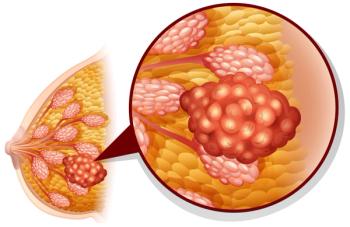
Health-Related QOL Persists With Nivolumab Plus Cabozantinib Vs Sunitinib for First-Line RCC
Better health-related quality of life outcomes were associated with nivolumab and cabozantinib for advanced renal cell carcinoma vs sunitinib.
Long-term follow-up of the CheckMate 9ER trial (NCT03141177) that were presented at the
In the exploratory analysis, patient-reported outcomes (PROs) were assessed using Functional Assessment of Cancer Therapy-Kidney Symptom Index 19 (FKSI-19) total score—which included disease-related symptoms (DRS), disease-related symptoms-physical (DRS-P), and functional well-being (FWB)—and the 3-level version of the EQ-5D (EQ-5D-3L)—which included UK utility index and visual analog scale (VAS).
Specifically, the FKSI-19 total score (range, 0-76) in the nivolumab plus cabozantinib arm (n = 323) was 58.74 (standard deviation [SD], 10.57) compared with 58.39 (SD, 9.92) in the sunitinib arm (n = 328). The DRS (range, 0-36) was 30.24 (SD, 5.19) vs 30.06 (SD, 5.03), the DRS-P (range, 0-48) was 38.19 (SD, 6.96) vs 38.14 (SD, 6.47), and the FWB (range, 0-12) was 7.17 (SD, 3.49) vs 7.08 (SD, 3.48) in the nivolumab plus cabozantinib group and sunitinib group, respectively.
Additionally, the EQ-5D-3L VAS (range, 0-100) was 74.23 (SD, 22.23) in patients who received the doublet combination and 75.68 (SD, 20.92) in patients who received sunitinib. The UK utility index (range, 0-1) was 0.78 (SD, 0.25) vs 0.73 (SD, 0.29), respectively.
In the open-label, randomized, multinational CheckMate 9ER trial, patients with previously untreated advanced or metastatic RCC were randomized 1:1 to receive either nivolumab intravenously at 240 mg once every 2 weeks plus cabozantinib by mouth at 40 mg once daily or sunitinib by mouth at 50 mg once daily for 4 weeks of each 6-week cycle.
Investigators presented updated efficacy data from CheckMate 9ER at the 2022 Genitourinary Symposium.
PRO score was an exploratory end point assessed in all randomized patients in the study. PRO instruments—FKSI-19 and EQ-5D-3L—were administered at baseline, before the start of each treatment cycle, and during follow-up visits 1 and 2 on 30 and 100 days from last dose. The EQ-5D-3L was also administered every 3 months during survival follow-up.
FKSI-19 measured disease-related symptoms of kidney cancer, and higher scores indicate better health state and effects of health-related QOL. VAS measured health status in 5 dimensions: mobility, self-care, usual activities, pain/discomfort, and anxiety/depression. Higher scores on both assessments were indicative of better health states.
For the FKSI-19, a form was defined as evaluable if at least 50% of the items had been completed. For EQ-5D-3L, a form was defined as evaluable if the VAS item was completed and all 5 items of the descriptive system had been completed.
MMRM adjusted for baseline scores and stratification factors and included all common timepoints (at baseline and every 6 weeks) through week 151 (approximately 37 months).
PRO Score Change from Baseline
The authors highlighted that PRO completion rates in both treatment arms were high (> 90%) at baseline but declined over time. At 115 weeks the completion rates remained high in both treatment arms (> 75% except for week 109, where it was 73% in the sunitinib arm). Baseline PRO scores were comparable between the nivolumab plus cabozantinib and sunitinib treatment groups and showed relatively low symptom burden.
Longitudinal changes from baseline in PRO scores was assessed using mixed-model repeated measures (MMRM). Estimated changes from baseline show that nivolumab plus cabozantinib had statistically significant improved health related QOL from baseline through week 151 (P < .05) in all scoring criteria except FWB.
Particularly, the overall least squares (LS) mean change from baseline for FKSI-19 total score was -0.47 in the nivolumab plus cabozantinib arm compared with -2.84 in the sunitinib arm (P < .0001). The overall LS mean changes for FKSI-19 DRS score were 0.71 vs -0.46, respectively (P < .0001). Regarding EQ-5D-3L health status score, the overall LS mean change from baseline was 2.73 in the investigative arm vs -0.95 in the control arm (P = .0001), and -0.01 vs -0.06 (P = 001), respectively for EQ-5D-3L UK utility index score.
Time-To-Event Analysis
Time to deterioration analysis was conducted for first (TTFD), confirmed (TTCD), and definitive (TTDD) deterioration events. Nivolumab plus cabozantinib significantly reduced the risk of first and confirmed deterioration in the FKSI-19 total, DRS, DRS-P, and FWB scores compared with sunitinib.
Specifically, TTFD for FKSI-19 total score had a median time to event of 6.24 months in the nivolumab plus cabozantinib group compared with 3.48 months in the sunitinib group (HR, 0.71; 95% CI, 0.57-0.87; P = .0011). In terms of DRS, the median time to event was 12.48 months vs 5.78 months, respectively (HR, 0.70; 95% CI, 0.56-0.87; P = .0017), and for DRS-P, the median time to event was 7.49 months vs 4.93 months, respectively (HR, 0.73; 95% CI, 0.59-0.91; P = .005). Finally, onset of FWB events occurred at a median of 19.38 months vs 6.97 months, respectively (HR, 0.69; 95% CI, 0.54-0.87; P = .0019).
In regard to TTCD, patients in the combination arm had a median time to first confirmed event of 18.23 months compared with 6.97 months in the sunitinib arm when evaluated by FKSI-19 total score (HR, 0.66; 95% CI, 0.52-0.84; P = .0005). In terms of DRS, DRS-P, and FWB in this analysis, the median TTCD was not reached (NR) for the combination vs 15.28 months (HR, 0.65; 95% CI, 0.50-0.86; P = .002), 10.05 months (HR, 0.56; 95% CI, 0.43-0.73; P < .0001), and 22.77 months (HR, 0.67; 95% CI, 0.50-0.88; P = .0045), respectively.
Also, nivolumab plus cabozantinib significantly reduced the risk of definitive deterioration compared with sunitinib in FKSI-19 total, DRS, and DRS-P scores, but not in FWB score. The median TTDD for FKSI-19 total score was 34.76 months in the investigative arm compared with 30.65 months in the sunitinib arm (HR, 0.68; 95% CI, 0.52-0.90; P = .007). In terms of DRS, the median TTDD was NR vs 34.5 months, respectively (HR, 0.53; 95% CI, 0.37-0.75; P = .0003). For DRS-P, the median was NR vs 32.23 months, respectively (HR, 0.52; 95% CI, 0.38-0.72; P < .0001). The median TTDD was not reached for either arm in the FWB analysis; the total number of events were 74 vs 69 in the combination and sunitinib arms, respectively (HR, 0.79; 95% CI, 0.57-1.11; P = .1715).
Nivolumab plus cabozantinib also significantly reduced the risk of deterioration in EQ-5D-3L VAS relative to sunitinib, irrespective of the definition used (TTFD, TTCD, or TTDD). Investigators noted that no significant difference was observed between treatment arms for the UK utility index. Specifically, the HRs for UK utility index were 0.86, 0.81, and 0.77, for TTFD, TTCD, and TTDD, respectively.
The median TTFD for EQ-5D-3L VAS was 13.86 months in the nivolumab plus cabozantinib arm compared with 4.67 months in the sunitinib (HR 0.74; 95% CI, 0.59-0.92; P = .0019). For TTCD, the median time to event was 34.56 months vs 17.74 months, respectively (HR 0.74; 95% CI, 0.58-0.95; P = .0183). Finally, the median TTDD was 37.65 months vs 31.28 months, respectively, for VAS analysis (HR 0.64; 95% CI, 0.48-0.86; P = .0026).
Investigators highlighted a specific item from the measures of disease symptoms in the FKSI-19 instrument in their analysis: item GP5: “I am bothered by [adverse] effects of treatment.” Responses were dichotomized as minimal bother (“not at all” or “a little bit”) vs notable bother (“somewhat,” “quite a bit,” or “very much”).
Overall, fewer patients in the nivolumab plus cabozantinib arm reported to be bothered by AEs compared with patients in the sunitinib arm. Patients who received the doublet were 48% less likely to be notably bothered by AEs than patients treated with sunitinib (odds ratio, 0.52; 95% CI, 0.35-0.77).
Authors of the poster wrote that item GP5 “is highlight associated with clinician-related adverse events and is supported as a single-item summary measure evaluating the impact of treatment-related toxicity.” Further, they noted that the item is recommended in the FDA oncology guidance as a core PRO for cancer clinical trials.2
References
- Cella D, Motzer RJ, Blum SI, et al. Health-related quality of life (HRQoL) in previously untreated patients with advanced renal cell carcinoma (aRCC): CheckMate 9ER updated results. J Clin Oncol. 2022;40(6):307. doi:10.1200/JCO.2022.40.6_suppl.307
- Core patient-reported outcomes in cancer clinical trials. FDA. Updated June 9, 2021. Accessed February 19, 2022. bit.ly/3v2yNmo
Newsletter
Stay up to date on recent advances in the multidisciplinary approach to cancer.





















































































